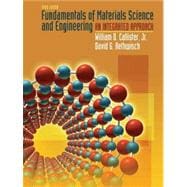
Note: Supplemental materials are not guaranteed with Rental or Used book purchases.
Purchase Benefits
What is included with this book?
| List Of Symbols | |
| Introduction: Learning Objectives | |
| Historical Perspective | |
| Materials Science and Engineering | |
| Why Study Materials Science and Engineering? | |
| Classification of Materials | |
| Advanced Materials | |
| Modern Materials Needs | |
| References | |
| Questions | |
| Atomic Structure and Interatomic Bonding: Learning Objectives | |
| Introduction: Atomic Structure | |
| Fundamental Concepts | |
| Electrons in Atoms | |
| The Periodic Table Atomic Bonding in Solids | |
| Bonding Forces and Energies | |
| Primary Interatomic Bonds | |
| Secondary Bonding or van der Waals Bonding | |
| Molecules | |
| Summary | |
| Important Terms and Concepts | |
| References | |
| Questions and Problems | |
| Structures of Metals and Ceramics: Learning Objectives | |
| Introduction: Crystal Structures | |
| Fundamental Concepts | |
| Unit Cells | |
| Metallic Crystal Structures | |
| Density Computations-Metals | |
| Ceramic Crystal Structures | |
| Density Computations-Ceramics | |
| Silicate Ceramics | |
| Carbon | |
| Polymorphism and Allotropy | |
| Crystal Systems Crystallographic Points, Directions, and Planes | |
| Point Coordinates | |
| Crystallographic Directions | |
| Crystallographic Planes | |
| Linear and Planar Densities | |
| Close-Packed Crystal Structures Crystalline And Noncrystalline Materials | |
| Single Crystals | |
| Polycrystalline Materials | |
| Anisotropy | |
| X-Ray Diffraction: Determination of Crystal Structures | |
| Noncrystalline Solids | |
| Summary | |
| Important Terms and Concepts | |
| References | |
| Questions and Problems | |
| Polymer Structures Learning Objectives | |
| Introduction | |
| Hydrocarbon Molecules | |
| Polymer Molecules | |
| The Chemistry of Polymer Molecules | |
| Molecular Weight | |
| Molecular Shape | |
| Molecular Structure | |
| Molecular Configurations | |
| Thermoplastic and Thermosetting Polymers | |
| Copolymers | |
| Polymer Crystallinity | |
| Polymer Crystals | |
| Summary | |
| Important Terms and Concepts | |
| References | |
| Questions and Problems | |
| Imperfections in Solids: Learning Objectives | |
| Introduction: Point Defects | |
| Point Defects in Metals | |
| Point Defects in Ceramics | |
| Impurities in Solids | |
| Point Defects in Polymers | |
| Specification of Composition | |
| Miscellaneous Imperfections | |
| Dislocations-Linear Defects | |
| Interfacial Defects | |
| Bulk or Volume Defects | |
| Atomic Vibrations | |
| Microscopic Examination | |
| General | |
| Microscopic Techniques | |
| Grain Size Determination | |
| Summary | |
| Important Terms and Concepts | |
| References | |
| Questions and Problems | |
| Diffusion | |
| Learning Objectives | |
| Introduction | |
| Diffusion Mechanisms | |
| Steady-State Diffusion | |
| Nonsteady-State Diffusion | |
| Factors That Influence Diffusion | |
| Other Diffusion Paths | |
| Diffusion in Ionic and Polymeric Materials | |
| Summary | |
| Important Terms and Concepts | |
| References | |
| Questions and Problems | |
| Mechanical Properties: Learning Objectives | |
| Introduction | |
| Concepts of Stress and Strain Elastic Deformation | |
| Stress-Strain Behavior | |
| Anelasticity | |
| Elastic Properties of Materials Mechanical Behavior-Metals | |
| Tensile Properties | |
| True Stress and Strain | |
| Table of Contents provided by Publisher. All Rights Reserved. |
The New copy of this book will include any supplemental materials advertised. Please check the title of the book to determine if it should include any access cards, study guides, lab manuals, CDs, etc.
The Used, Rental and eBook copies of this book are not guaranteed to include any supplemental materials. Typically, only the book itself is included. This is true even if the title states it includes any access cards, study guides, lab manuals, CDs, etc.